January 30, 2009
Air Date: January 30, 2009
FULL SHOW
SEGMENTS
Green Beginnings
/ Jeff YoungView the page for this story
The new president puts the pedal to the metal on fuel efficiency for cars and the new Congress pumps billions into clean energy investment-proof that change has come to Washington when it comes to dealing with climate change. Living on Earth's Washington correspondent Jeff Young tells us the latest and why Al Gore says the economic recovery plan can fight global warming. (06:30)
Stimulating Smarter Utilities
View the page for this story
Traditionally, power companies make more money when they sell more power. But a different business model before Congress has utility companies promoting energy efficiency measures and still turning a profit. Host Bruce Gellerman speaks with Joe Romm, Senior Fellow with the Center for American Progress and manager of the blog “climateprogress dot org” about the scheme known as “decoupling.” (05:30)
Golden Rice
/ Julie GrantView the page for this story
Rice genetically modified to produce Vitamin A could be the answer to some childhood health problems in the developing world. But some farmers, health advocates, and environmentalists are voicing concerns. In a story originally produced for “The DNA files” Julie Grant has our report. (12:20)
Honey Laundering
View the page for this story
The tale of honey is not all sweet. In an eight part investigative series in The Seattle Post-Intelligencer, reporter Andrew Schneider looks at the origins of imported honey and the lack of oversight by federal agencies. Schneider tells host Bruce Gellerman that Chinese honey makes up about a third of honey consumed in the U.S. and, he says, some of it is watered down with corn syrup and contains antibiotics illegal here. (05:30)
Note on Emerging Science
/ Jessica Ilyse KurnView the page for this story
New research shows that licking your wounds, literally, might be good for you. Jessica Ilyse Smith reports. (01:50)
Of Bears and Men
/ Matthew BrunwasserView the page for this story
For centuries, captive bears have made money for their gypsy owners by dancing in the streets of Europe. But thanks to the efforts of actress Bridget Bardot and an Austrian animal rights group, the last of the dancing bears have been placed in a cushy retirement home in the mountains of Bulgaria. And, as reporter Matthew Brunwasser reports, that isn’t sitting well with some of the local humans. (08:30)
Woman Who Speaks Tree
View the page for this story
Linda Tatelbaum has been homesteading in the woods of Maine with her husband since 1977. She reflects on her life, work, and beliefs in her new book "Woman Who Speaks Tree: Confessions of a Tree Hugger." Steve Curwood chats with her about what she's learned from the trees that surround her home and why she may have to cut some of them down. (06:45)
Show Credits and Funders
Show Transcript
Host: Bruce Gellerman
Guests: Joe Romm, Andrew Schneider, Linda Tatelbaum
Reporters: Matthew Brunwasser, Julie Grant, Jeff Young
Science Note: Jessica Ilyse Smith
[THEME]
GELLERMAN: From Public Radio International - this is Living on Earth.
[THEME]
GELLERMAN: I’m Bruce Gellerman.
President Barack Obama wastes no time tackling climate change:
OBAMA: I want to be clear from the beginning of this administration that we have made our choice. America will not be held hostage to dwindling resources, hostile regimes, and a warming planet.
GELLERMAN: The price tag to avert climate disaster is enormous. What will we get for the money?
Also, a scheme for utilities to make more money by selling less energy. It’s called decoupling. California has been doing it for decades.
ROMM: If the entire country had the same electricity grid as California then we would actually reduce U.S. total greenhouse gas emissions by a third, but our energy bills wouldn't be any higher.
GELLERMAN: And, the dancing bears of Bulgaria live the high life to the chagrin of some locals. Chagrin and bear it. This week on Living on Earth.
[NEWSBREAK MUSIC: Boards Of Canada “Zoetrope” from “In A Beautiful Place Out In The Country” (Warp Records 2000)]
ANNOUNCER: Support for Living on Earth comes from the National Science Foundation and Stonyfield Farm.
Green Beginnings
[THEME]
GELLERMAN: From the Jennifer and Ted Stanley Studios in Somerville, Massachusetts - this is Living on Earth. I’m Bruce Gellerman, in for Steve Curwood.
Talk about hitting the ground running. Candidate Barack Obama promised change and change is now definitely in the air. The new president quickly put climate change and the nation’s dependence on oil near the top of his agenda.
OBAMA: I want to be clear from the beginning of this administration that we have made our choice. America will not be held hostage to dwindling resources, hostile regimes, and a warming planet.
GELLERMAN: Living on Earth’s Washington correspondent Jeff Young joins me to analyze the flurry of environmental action. And Jeff the president really put the pedal to the metal.
YOUNG: That’s a good term since we’re dealing with cars here. And not just the president, but also the new congress – there was a lot of action on Capitol Hill. I think the climate has changed here for climate change.
GELLERMAN: [LAUGHS] Okay, we’re gonna stop that. What do these two executive orders the president signed mean for the kinds of cars and trucks we’ll be driving?
YOUNG: Well it should mean that we’ll have more fuel-efficient vehicles to choose from in the coming decade. The minimum goal is for the carmaker’s overall fleet to average 35 mpg by 2020.What Obama signed put into motion the rules so that we should start seeing higher mileage cars with the 2011 model year. Now, the second thing he did is more controversial and that has to do with letting states regulate the greenhouse gases that come out of tailpipes.
GELLERMAN: That’s what California had wanted permission to do, but the Bush administration said no.
YOUNG: Yeah, last March the head of Bush’s EPA said no to that request even though his own staff lawyers and scientists said, “We should say yes to this.” Now Obama’s EPA is gonna have another look. And it’s almost a foregone conclusion they’ll say yes this time, that California can regulate auto emissions. Thirteen other states say they will follow suit.
That means - could mean that roughly half the US auto market would then require those higher mileage cars much faster, about four years sooner.
GELLERMAN: And I don’t think anyone was surprised by Detroit’s response to this.
YOUNG: They hate this idea of letting states take the lead here. The auto industry’s already gone to court to try to block that. And most observers say they expect the industry to sue again if California and the other states proceed.
GELLERMAN: Now didn’t the government just give GM and Chrysler a 23 billion dollar bailout check?
YOUNG: Our dollars, that’s right, and I talked with Charlie Territo about that. He’s the spokesperson for the Alliance of Automobile Manufacturers. Here’s an exchange from that conversation:
TERRITO: We think the best way to achieve higher fuel economy for the entire fleet is through a single national standard and not a state-by-state patchwork
YOUNG: Part of the sales pitch when you came to Capitol Hill was, “We want to make greener, cleaner cars.” If you want to make greener, cleaner cars why are you taking our money to fight lawsuits against it?
TERRITO: Those lawsuits are there to protect the industry. There is room for cooperation and I think that in the next few months we’ll be looking forward to working closely with the Obama administration and explaining to them the wisdom of a single national standard.
GELLERMAN: So the carmakers are basically saying they want to cooperate but they’re not dropping those lawsuits!
YOUNG: Yeah, this is something they’re gonna fight over. The industry says they need more lead time to introduce those higher mileage cars. Also, the state standards don’t let them average things out over a broad national fleet. And that would mean they wouldn’t be able to sell their more profitable vehicles in those states. For the most part those are the light trucks, which don’t get as good mileage. So the industry’s gonna push for that one national standard. The states and their environmental allies will push for the state standards to become the norm. And in the backdrop, of course, you’ve got the whole industry teetering on the brink of bankruptcy. It is not at all clear to me how this is going to play out exactly.
GELLERMAN: Let me change gears a little bit here, Jeff. Former Vice President Al Gore was also in DC this past week and he was delivering some inconvenient truths.
YOUNG: Yes, the return of the Goracle we call it here. He spoke to the Senate’s foreign relations committee about the next big international climate change talks. They’re coming at the end of the year in Copenhagen.
GELLERMAN: But the Bush administration refused to sign on to the last international agreement, the Kyoto accords. What does Mr. Gore think it will take to get us on board with a new climate agreement?
YOUNG: Like a lot of people who work on this issue Gore says, the US first needs its own domestic controls on greenhouse gas emissions - a cap and trade system to limit CO2. That’s still very tough, politically - even with the new president. What I found interesting in Gore’s remarks is he thinks this economic recovery package that Congress is working on right now, he thinks that’s the first step on that path toward a global warming agreement.
GORE: The plan’s unprecedented and critical investments in four key areas – energy efficiency, renewables, a unified national energy smart grid and the move to clean cars – represent an important down payment and are long overdue.
YOUNG: Now Gore is talking there about the House version of the Economic Recovery Act, it passed the House. It has about 80 billion dollars for clean energy and efficiency, clean cars and mass transit. The Senate’s bill, eh, not so much. The full Senate takes up the bill next and Gore says he’s not as happy with the version that’s emerging there. House Speaker Nancy Pelosi says she’ll fight to preserve the greener elements the House put in.
GELLERMAN: But no matter what the bottom line is, we’re talking huge bucks here, Jeff?
YOUNG: Oh, it’s mind-blowing. The House version came in at 819 billion. The Senate’s version could go as high as 900 billion - we don’t know quite yet. It’s just mind-blowing. You know, watching these developments - with the auto emissions standards and the government getting involved with this enormous government investment in the economic recovery –You really get the sense that the center of gravity in this country has shifted. Detroit and Wall Street have stumbled badly, they’re broke. Washington and the Treasury is the only place now with real power and real money. We don’t know how all of this is going to play out exactly; with cars and the way we get our electricity. But however it happens, it’s gonna happen here.
GELLERMAN: Well we’re glad you’re there Jeff. Living on Earth’s Washington correspondent, Jeff Young.
Thanks a lot, Jeff.
YOUNG: You’re welcome.
Related links:
- ***WEB EXTRA*** Listen to Jeff Young interview a spokesperson from the Alliance of Automobile Manufacturers about the President’s proposals, the auto industry bailout, and the industry’s continued opposition to fuel-economy improvements.
- President Obama’s comments on fuel economy standards and auto emissions.
- Environment America analyzes the green elements of the House version of the economic stimulus bill.
Stimulating Smarter Utilities
GELLERMAN: As any kid with a sidewalk lemonade stand knows - the more lemonade they sell, the more money they make. That’s the same business model that energy utility companies traditionally use. More sales, more profit. Now, imagine selling less and making more.
Well, basically that’s part of the Obama administration’s economic stimulus plan. It’s called decoupling. And joining me to explain how decoupling works is Dr. Joe Romm.
He’s a senior fellow with the Center for American Progress. Dr. Romm, welcome.
ROMM: My pleasure.
GELLERMAN: Decoupling sounds like economic alchemy. How does it work?
ROMM: Well, as you said, utilities make more money by selling more electricity. And if they can sell enough more electricity then they can build new power plants and increase utility rates. So they sort of have a double incentive to get people to use more electricity. That’s the way the regulations are written. Now a few smart states like California and Maryland have rewritten utility regulations to decouple utility profits from the sale of electricity, and that is called decoupling.
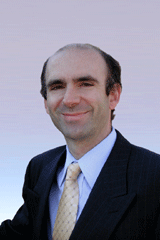
Joseph Romm.
ROMM: Well, the way they do it is they raise rates a very small amount, one or two percent on everyone and use that money to help subsidize energy efficiency rebates and energy efficiency audits and other programs to help customers save money, so that they replace new power generation with saved electricity. So, instead of raising your rates a lot with let’s say building a new nuclear or coal plant, they raise rates a very little and then actually lower your energy bill by helping you become more energy efficient. So, when you change the regulations, you can actually deliver much more energy services for much less money.
GELLERMAN: There was a report out I guess by University of California Berkeley that said that the average Californian uses 40% less power than the average American uses.
ROMM: Yes, that’s right. The average Californian uses about 40% less electricity than the average American, while obviously living, you know, a very gadget oriented, high tech lifestyle.
GELLERMAN: Well, it sounds like a no-brainer then. How many other states are considering this?
ROMM: Well a number of other states are considering it. I think most importantly is that Congress has put into the stimulus bill a requirement that if a state is gonna take money for energy efficiency, they are gonna have to change their utility regulations. And I expect that in the energy bill that will be coming out of Congress later this year after the stimulus bill, there will be other efforts to encourage decoupling.
GELLERMAN: But what do the utilities say about this. They must love the idea.
ROMM: Well, in the beginning, they were kind of hesitant and often opposed to this just because they’ve been making money the old fashioned way for, you know, almost a century. But, yes, there’s no question that if you were to talk to, for instance, Pacific Gas and Electric in California, they would tell you that they are very happy with the new model because energy efficiency has other benefits to the utility. It means that they don’t have to build new power plants and site new power lines and, of course, those things annoy the public. So, yes, the utilities that have come to adopt this, many of them are very happy about it.
GELLERMAN: Dr. Romm, what’s the potential here for decoupling? I mean if every state took decoupling measures, what would that mean in terms of energy saved and dollars saved?
ROMM: If the entire country has the same electricity grid as California, then we would actually reduce U.S. total greenhouse gas emissions by one third, but our energy bills wouldn’t be any higher. So, I think the potential savings are enormous both environmentally and in people’s energy bills.
GELLERMAN: Another part of the president’s stimulus package has something called smart metering. What’s that?
ROMM: Well, right now your meter is often in your basement, as it is in my home, or outside your house. You have no idea how much electricity you’re using on a daily basis. So, wouldn’t it be nice to be able to call up on your computer what your electricity use is any time? It turns out when you do that, people are encouraged to use energy more efficiently. In places like California they have tried having your meter control some of your appliances so that during times of peak power demand where you’re approaching a blackout, the utility can actually cycle your air conditioning unit off fifteen minutes every couple of hours and you won’t notice, but it might save the entire grid from collapsing. So, as we move toward smarter appliances and electric cars and distributed renewable energy were are definitely going to need smarter meters.
GELLERMAN: Dr. Romm, thank you very much.
ROMM: My pleasure.
GELLERMAN: Joe Romm is a senior fellow with the Center for American Progress and he runs the blog Climateprogress.org.
[MUSIC: Tom Rossi “Coupling” from First One (Salma Har Productions 2004)]
GELLERMAN: Just ahead – how sweet it isn’t - imported honey. Keep listening to Living on Earth!
[CUTAWAY MUSIC: Booker T & The MG’s: “Kinda Easy Like” from Melting Pot (Stax Records 1983)]
Related link:
Joseph Romm's blog
Golden Rice
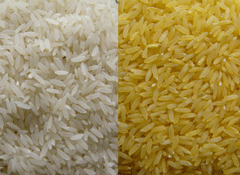
Common, and golden rice. (Golden Rice Humanitarian Board © 2007)
GELLERMAN: It’s Living on Earth, I’m Bruce Gellerman.
Golden rice was developed about 20 years ago. Orange in color, it was genetically engineered to be rich in beta carotene, a nutrient our body converts into Vitamin A. Scientists hoped Golden Rice would save lives and the eyesight of a quarter of a billion kids worldwide not getting enough vitamin A in their diets, children who typically live in less developed countries where ordinary rice is a dietary staple.
The creators of Golden Rice planned to offer it to farmers for free. But now, nearly two decades later, the bio-engineered rice is still not available. Julie Grant traveled to India to find out why, for a story that originally aired as part of the series: “The DNA Files.”
GRANT: Just a few minutes drive outside the southern Indian city of Madurai, the crowded streets of food vendors, auto rickshaws, and cars give way to small villages and green countryside. It's a patchwork of farm after farm. There are no barns or outbuildings. There are hardly any tractors. People here do most of their farm work by hand. 77-year-old Dr. Lakshmi Rahmathullah has been working with people in these villages for most of her career. Today, she's gathered some of the children in Arasakulam village. Six-year-old Karthik Kumar bravely walks to the front of the group as an adult holds his head steady for Dr. Lakshmi.
RAHMATHULLAH: If you look at his eyes, you will see brownish folds on the white part of the eye, which shows that is an indication of Vitamin A deficiency.
GRANT: Another child here, a ten-year-old girl said she couldn't see at night. She said it was scary. Everyone looked like ghosts. These symptoms, if left untreated, can lead to much worse problems. Her cornea could have literally shriveled away, leaving her totally blind. But the kids here were lucky. They got high dose Vitamin A supplements. This ten-year-old girl got her eyesight back within four months. International aid organizations estimate that fully a third of children under age five in India and Southeast Asia have some level of vitamin A deficiency.
About two-thirds of Indian children under age five get Vitamin A supplements. They line up twice each year at health clinics to receive a spoonful of the serum. A mega dose of Vitamin A is stored in the child's liver, and is slowly released through the months.
But there's debate in India over the need to continue the supplementation program. Dr. H.P.S. Sachdev is former president of the Indian Academy of Pediatrics. He's a small man in a dark blue turban. Sitting in his medical office, he says most children these days don't need the mega doses
SACHDEV: I view it as a medicine. God did not intend us to take a pill off and on.
GRANT: Sachdev says many Indian families have gained the education and financial means to meet their vitamin A needs the way people in richer countries do - through those orange vegetables and leafy greens. So children should only get the mega doses if there's an obvious lack of Vitamin A in their diet.
Sachdev says there's another way to meet low level needs - golden rice. That's the rice genetically engineered to express beta-carotene. Sachdev says children could just eat a little rice regularly.
SACHDEV: A small lower dose mimics the daily requirements or is much closer to the daily requirements and its chances of toxicity are much lower as compared to a huge pill based on the mega dose approach.
JULIE GRANT: Ten years ago, Dr. S.R. Rao, director of India's Department of Biotechnology, was touring laboratories in Switzerland, and met geneticist Ingo Potrykus. Potrykus was still experimenting then, trying to make rice express beta-carotene. Rao says he wanted that rice for India, because he thought it could go a long way to reduce Vitamin A deficiency in regions where rice is a staple in the diet.
RAO: So I'm from the southern part of India, and we only eat rice and rice and
rice.
GRANT: Rao says they often eat rice for breakfast, lunch, and dinner. But why would farmers in India want to plant Golden Rice? Dr. Rao is a leader in efforts to transfer the genes for Golden Rice into varieties Indians already eat.
[SOUND OF STERILIZER]
Dr. Rao takes us to what's called a phytotron. It's a building used to grow plants, but it doesn't receive natural light like a greenhouse. That sound is a sterilizer. Before you enter the phytotron, you've got to spend a couple of minutes in this chamber. It blows super high air pressure to clean off contaminants that could ruin the experiments.
RAO: To really get clear of your dust and all the organisms and you just come to this side. Now they're coming out. Okay?
GRANT: The phytotron's main room has row after row of huge aqua colored refrigerators that keep the young plants at a constant temperature. Inside are Indian hybrids of Golden Rice. The genetic modification, the beta-carotene, was originally bred into a Japanese rice variety. Rao says in his phytotron they bred the Golden trait into some popular Indian varieties.
RAO: That is in terms of their yield, in terms of resistance to diseases and pests. Such varieties have been taken, and where we put this traditional trait of Golden Rice.
GRANT: So traits that farmers like?
RAO: Traits farmers like.
GRANT: Because they're going to grow better. They're not going to have as many pests.
RAO: Yes, exactly.
GRANT: What he expects farmers to like even more is that the government plans to give Golden Rice seeds free to those making under $10,000 a year. This is possible, because of a deal struck between Ingo Potrykus, the scientist who created Golden Rice, and the seed company, Zeneca.
There are some 70 patents on the various technologies involved in making Golden Rice. Zeneca, which is now part of Syngenta, owns many of those patents. The company was interested in selling Golden Rice to the U.S. and European health food markets. So in exchange for the right to do that, the company agreed to give the seeds away free to developing nations.
But those free seeds are making some people angry. Vandana Shiva is famous worldwide for her opposition to genetically modified foods and the companies that pervade GM seeds. She calls Golden Rice a hoax, and says there are more natural ways for Indians to get Vitamin A.
SHIVA: You can add a few micrograms of Vitamin A to a white, polished rice, and be thrilled that you have added nutrition. But again, food is not just rice, and definitely for anyone who has even a kindergarten knowledge of nutrition, polished rice is not where you turn to for meeting your Vitamin A needs. You turn to your greens. You turn to your coriander, your curry leaves, something very, very central to our eating.
GRANT: 60% of Indians are farmers, but many don't grow food for themselves any more. Ever since the Green Revolution brought pesticides and fertilizers to India in the 1960's, Shiva says farmers have been growing cotton and rice for the commodities market instead of food for their families. She says they need to be reeducated to grow and eat those leafy greens and other vegetables rich in Vitamin A.
[MUSIC]
GRANT: But farmers aren't unified in what will be the best future for Indian agriculture. Some are clamoring for the latest technologies. There's a black market for genetically modified cotton seeds.
But other farmers and activists agree with Shiva. Last year, GM opponents convinced the Indian Supreme Court to temporarily ban any new genetically modified crops from being planted, saying the crops were bad for human health and the environment. The ban has since been lifted.
Some farmers worry GM crops could destroy their export market. Northern India in the shadow of the Himalayas is the main world region for growing basmati rice. Basmati is a huge export crop for Indian farmers.
Gurnam Singh is leader of the BKU Farm Union in this state, Haryana. Last year, he got wind that one of the multinational biotech companies had planted an experimental plot of genetically modified rice in the midst of the basmati region. Today, he rides up to that plot on his motorcycle, but there's no genetically modified rice here any more. Singh rallied a group of farmers, at least 100 by some counts. They piled straw over the small test site, poured some kerosene, and basked in the heat of the message they were sending to Monsanto.
GURNAM SINGH: (In Punjabi)
TRANSLATOR: He's saying they met here basically as a sign of protest towards the company, because they were doing something - something, which would harm the farmers, and so basically this was supposed to be a sign of protest for them by burning.

Except for its color, the only difference between common rice and golden rice is that it produces and accumulates vitamin A in the grain. (Golden Rice Humanitarian Board © 2007)
SWAMINATHAN: I was happy, because I thought it was wrong.
GRANT: He says the company shouldn't have planted genetically modified rice in India's basmati rice region, because of the possibility of cross-pollination.
SWAMINATHAN: It was foolish to have gone there, in the heartland of the rice-exporting region, basmati rice, because we all know genetic pollution, gene flow, genetic contamination.
GRANT: Swaminathan says contamination could ruin India's rice trade with Europe, Japan and other countries that don't accept genetically modified imports. But he says there are many places in India where genetically modified crops do make sense, and will be necessary to grow enough food for India's growing population.
SWAMINATHAN: Genetic modification is one more tool, which can help you to overcome certain problems.
GRANT: He remembers when his family couldn't get rice. It was rationed by the government. People were asked to fast one day a week, because there wasn't enough food in India. He says it's time for the government to make policies that will provide enough food.
SWAMINATHAN: Why, because we've got 1.1 billion people today - it will be 1.5 billion - the largest population in the world. Who is going to feed us? A country like India cannot depend on others to feed this population. And I think it's the fundamental duty of a government to ensure the daily bread to everybody.
GRANT: If Syngenta is serious about giving away Golden Rice for free, Swaminathan says it should drop its patents. Syngenta says poor farmers in India will never have to pay for Golden Rice, but the company may want to use the technology elsewhere. So it's holding on to its patents.
There are also questions about how much it will cost to complete development, to distribute seeds, to ensure children actually eat it, and that it provides enough Vitamin A.
Back in Araskulam Village in southern India, Dr. Lakshmi Rahmathullah wouldn't mind seeing Golden Rice on these small farms, but she says for the sake of its children, it's too soon for the Indian government to stop offering Vitamin A supplements.
RAHMATHULLAH: There is no best solution. Offer families fortified rice, offer families fortified salt, offer families Vitamin A solution. Multiple solutions are the best answer.
GRANT: Dr. Lakshmi says the most important thing to offer malnourished families is food they can afford. I'm Julie Grant.
GELLERMAN: Our story on Golden Rice comes to us courtesy of SoundVision Productions in Berkeley, CA. And this update: The Rockefeller Foundation has announced it will provide funds to help Golden Rice pass through the regulatory process in India, Bangladesh, Indonesia, and the Philippines.
Related links:
- The DNA Files series
- For more about golden rice, click here
[MUSIC: Sofa Surfers “Rice And Beans (Mad Professor Dub)” from Constructions (Klein Records 2007)]
Honey Laundering

A honeybee at work. (Photo: Scott Bauer, USDA/ARS)
GELLERMAN: Americans have a sweet tooth for honey. We eat over a pound of honey per person a year. Honey is healthy and the stuff of sweet dreams - a major ingredient for Winnie the Pooh bedtime stories.
But just as Pooh got stuck digging deep in a honey pot, last spring West Coast importers got stung when a federal swat team swooped down and busted them for honey trafficking.
Andrew Schneider, a senior correspondent for the Seattle Post-Intelligencer, investigated honey imports. And his eight part series reads more like James Bond than Pooh Bear.
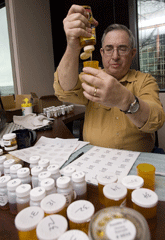
Andrew Schneider taking samples of honey for his investigative series for the Seattle Post Intelligencer. (Photo: Seattle Post Intelligencer)
GELLERMAN: So we’re consuming a lot. And a lot of that, you write, comes from China. I guess about half of the remaining imports.
SCHNEIDER: Yeah, that’s pretty much what we figured out. They’re most often marked as coming from other countries: Vietnam, Korea, India, Australia. But in most cases they are from China, and just illegally relabeled.
GELLERMAN: You have a great turn of a phrase – you call it honey laundering. And I guess the honey that we get from China is supposed to have a tariff. So what these companies do is they send it off to another country and label it coming from that country when it’s really coming from China.
SCHNEIDER: Right, you’ve defined honey laundering very well, Bruce. They avoid the tariffs by shipping it to a country that has no tariffs. And they also avoid the added scrutiny that’s often applied to Chinese honey, because Chinese honey has been found to be contaminated over the years with antibiotics that the FDA declares illegal.
GELLERMAN: When honey enters the United States from China or from any place else, isn’t it tested for safety?
SCHNEIDER: It depends who you ask. The closer that we got to the headquarters of FDA and the Immigration and Customs Enforcement Agency, the more people were insisting that they inspect every shipment of honey. But, Bruce, when you get to the field, when you get to the front lines, the ports, the Canadian borders, and talk to the people that are really assigned to do this, it’s just not happening. I mean, they just giggle at you. When we interviewed the head of the FDA program, a guy named Martin Stutsman, the headquarters was saying that we’re on top of this stuff. And Stutsman admitted that in the last year they’d actually inspected fewer than one hundred drums of honey. And hundreds of thousands of drums actually arrive each year.
GELLERMAN: Well what about the importers, the companies that actually, you know, purchase the honey in volume and then sell it over here. Don’t they test their own products?
SCHNEIDER: Not so much. Rarely, actually. One of the things that’s really gotta be understood is regardless of how sinister or criminal the Chinese honey shippers may be, they couldn’t get their honey into this country unless there were people here that were willing to close their eyes and make believe that it’s not from China. I mean, it’s pretty obvious. The going price for good honey, from Canada, for example, might be a buck sixty a pound. Australian honey might be a buck forty a pound. If all of a sudden, as a honey packer, you’re being offered three hundred thousand pounds of honey at fifty cents a pound, wouldn’t you think you might wonder a bit about why you’re getting such a great price.
GELLERMAN: Well we’ve been talking about honey, and one of the things you write about in your article is that actually, there is no legal definition of what honey is in this country. I mean, you could put another in a jar and call it honey?
SCHNEIDER: That’s correct. You can call it anything you want and you can put anything you want in the jar. And you can call it honey. Neither the FDA nor the USDA has a legal definition of honey. Which means that enforcing the quality of honey becomes extremely difficult and problematic. If it has a recognized hazardous or illegal substance like the antibiotics the Chinese use, then you can pull it off the market. But if it has any number of other things – like if it’s mixed with sugar water or corn syrup or something, there’s really nothing there in the regulations that say that “Thou shalt not do this.”
GELLERMAN: What about the labeling where it says organic?
SCHNEIDER: Well, if its says made in the U.S. organic honey, the chances are almost totally that they are wrong. Mainly because you can’t control where the bees fly. Now that doesn’t mean there isn’t organic honey. There are parts of South America that are totally undeveloped. There are parts of Northern Canada that have no commercial farming whatsoever, and there is organic honey coming from those places, but if it says made in the U.S.A. organic, I’d be very suspicious of it.

(Photo: Scott Bauer, USDA/ARS)
SCHNEIDER: I liked it a lot more before I started researching this story.
GELLERMAN: Investigative reporter Andrew Schneider’s eight part series about imported honey appears in the Seattle Post Intelligencer. We contacted Martin Stutsman of the Food and Drug Administration and he confirmed the government does test only about 100 barrels of imported honey a year.
STUTSMAN: Honey is a low risk commodity. We don’t have a lot of problems with honey.
GELLERMAN: Why is there no legal definition of honey. I understand that you can actually put sugar water or fructose in a plastic bear and call it honey because there is no regulation.
STUTSMAN: We don’t have a regulation specifying what honey is. But honey is commonly understood to be the material produced by bees from nectar of flowers and deposited and dehydrated by the bees in the honeycomb.
GELLERMAN: And Martin Stutsman says the FDA has and does cite packagers who mix fructose with honey.
[MUSIC: Emily Remler “A Taste OF Honey” from Firefly (Concord Records 2000)]
GELLERMAN: Just ahead: dancing bears in Bulgaria. Stay tuned to Living on Earth.
ANNOUNCER: Support for the Environmental Health Desk at Living on Earth comes from the Cedar Tree Foundation. Support also comes from the Richard and Rhoda Goldman fund for coverage of population and the environment. And from Gilman Ordway for coverage of conservation and environmental change. This is Living on Earth on PRI, Public Radio International.
Related links:
- To see Andrew Schneider’s 8 part series on honey click here
- For FDA Rulings and information on honey, click here
[CUTAWAY MUSIC: Ivan “Boogaloo” Jones: “You’ve Got It Bad, Girl” from Sweetback (Ubiquity Records 1998)]
Note on Emerging Science
GELLERMAN: It's Living on Earth, I'm Bruce Gellerman. Coming up: the tree whisperer speaks.
But first this Note on Emerging Science from Jessica Ilyse Smith.
SMITH: We get a lot from our pets—love, affection, even adventure…but, health care lessons?
[THEME MUSIC]
SMITH: Now, A group of scientists from the Netherlands has determined that perhaps we too should lick our wounds. The researchers used cells from the inside of a human mouth to test if human saliva carries wound-healing properties. They grew the cells in Petri dishes and crafted artificial wounds. Half of the dishes were doused in human saliva and half were left untouched. After 16 hours, the dishes showed that the wounds treated with saliva were mostly closed, while the untreated wounds had not healed!
By isolating different salivary compounds and redoing the test, the scientists identified that the compound histatin was the healing ingredient in human saliva. Histatin is a protein that has strong fungicidal and anti-microbial properties, which account for its wound-healing function.
This finding has broad applications, since histatin-like compounds can be synthetically manufactured on a large scale. In the first round of studies, the researchers used simplified wound models; future experiments will test tissue-like wounds. There is hope that histatin will be a good candidate for a broad array of wound-healing—anything from minor cuts to treatment from burns and surgery.
So, next time you return from a day of rolling around in the sun with your dog—follow his lead and lick your wounds!
That’s this week’s note on emerging science; I’m Jessica Ilyse Smith.
Of Bears and Men
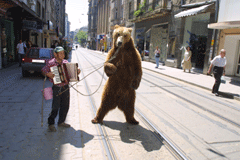
A bear dances on the streets of Bulgaria. (Photo: Mihai Vasile/VIER PFOTEN)
GELLERMAN: Since the 1970s French actress Bridgette Bardot has turned away from films and devoted her energies to animal rights. A few years ago, Bardot was instrumental in creating a refuge for dancing bears - bears that once performed on the streets of Europe.
The reserve was built in the mountains of southwestern Bulgaria but for many residents there, the animals are better off than they are. From Belitsa, Bulgaria, Matthew Brunwasser has our report.
[MUSIC, CHAINS JINGLING AND SOMEONE SPEAKING IN GERMAN]
BRUNWASSER: Wandering gypsies, leading bears in chains, have performed across Europe since the Middle Ages, in scenes like this one. Taken from the 1996 documentary film “Of Bears and Men,” it shows a bear-keeper and his dancing bear busking for German tourists on Bulgaria’s black sea coast.

A dancing bear before rescue.(Photo: Mihai Vasile/VIER PFOTEN)
BRUNWASSER: In the modern era, the antiquated tradition has only survived in the Balkans and former Soviet Republics, where people believed that touching a bear could bring good luck. Or that if a bear lay on top of you, it could cure back pain. But after Western animal rights groups came to Bulgaria in the 90s, they publicized the severe pain suffered by the bears, controlled by steel rings through their fleshy, dog-like noses. In another scene from the film by Asen Vladimirov, a bear cub is taught to “dance” by being forced to walk on hot coals.
[BABY BEAR GROWLING, CHAINS JINGLING]
BRUNWASSER: The last Bulgarian bears were purchased two years ago. Animal rights activists paid about five thousand dollars for each one, so their human owners could find a new trade, that didn’t involve harming animals. And to take care of the bears, an animal rights group, Four Paws, and Bridgette Bardot built an enormous bear park.
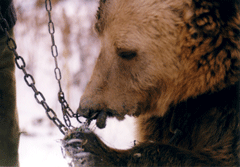
(Photo: Mihai Vasile/VIER PFOTEN)
[SOUND OF BEAR WALKING ON GRAVEL]
BRUNWASSER: Its hard to hear in this recording, but this former dancing bear, now free in the park, is pacing three steps forward, two steps back, despite the fact that it now has 30 acres of wilderness in which to roam. Unaccustomed to life without chains, most of the bears continue this “dance,” for months or even years after their release.
[BEARS BREATHING AND LIP-SMACKING]
BRUNWASSER: Their deluxe living space also includes a varied and plentiful food, which comes regularly.
[SOUND OF BREAD HITTING THE GROUND, BEAR MIP SMACKING]
BRUNWASSER: That’s the sound of loaves of bread, tossed from the top of the visitors’ center into the fenced-off habitat for bears. The food too speaks of the bears’ lifetime of captivity and the company of humans. It's not what they would have eaten in the wild. Dimitar Ivanov is the manager of the park.
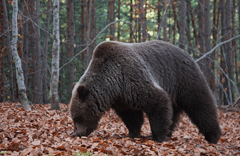
Enjoying retirement.(Photo: Mihai Vasile/VIER PFOTEN)
[TERRITORIAL THROATY BEAR ROARS]
BRUNWASSER: This bear is not shy about expressing its instinct to protect its territory, even though there is plenty for all.
[BEAR GROWLING]
BRUNWASSER: Besides caring for the bears, the park’s mission is to educate visitors about wildlife and animal cruelty. Most of the bears’ faces are scarred or shredded. And they will never again be able to survive in the wild. All the males were castrated when they arrived at the park, so when the last bear dies of old age, the park will have completed its function.
[BEAR ROARS]
BRUNWASSER: For Belitsa’s human residents however, the future is not so bright. The last 20 years of political and economic changes following the end of communism have hit Belitsa hard. The small factories where people use to work here have crumbled. People in Belitsa don’t talk about reducing their carbon footprints, or transportation with a low environmental impact. They live it.
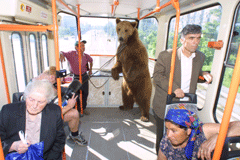
(Photo: Mihai Vasile/VIER PFOTEN)
BRUNWASSER: I hitched a ride with Mitko Dimitrov and his crew of woodcutters as they commuted to work up into the mountains on a horse-drawn cart. We passed people working large gardens by hand. Almost everyone eats organic and local here, but not out of choice. The bears on the other hand, don’t have to worry. Dimitrov says the people in town are jealous of their bears. There’s even a saying: there’s nothing better than to be a bear in Belitsa.
DIMITROV: (IN BULGARIAN) The people in Belitsa are hungry, the bears eat. That’s the whole thing. I see a lot of food going to the bears, an obscene amount of food. They bring them pears, huge, fresh and juicy. Big white juicy grapes, the eating kind. The bears in Belitsa live better than the people.
BRUNWASSER: Dimitrov’s income is around two hundred dollars a month, the same as each bear’s food budget. He’s never visited the park, but not because he holds any grudges.
DIMITROV: (IN BULGARIAN) It’s interesting, but you need to have money to go up there and look at the bears, Euros. And for the last three months, we haven’t even been able to take off a single day for a weekend. Not one single day!
[STREET NOISE]
BRUNWASSER: In contrast to the majestic Alpine scenery, the streets of Belitsa are scrappy, dirty and do-it-yourself. Maria Bankova is sitting in front of her house, taking a break from chores. She wants to show me how rough her hands are, despite her profession as a math teacher. If you don’t work the land here, you don’t eat. Bankova says the money from abroad could be used for more important things.
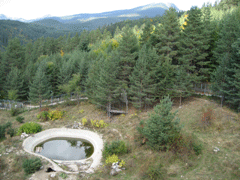
The bear park.(Photo: Mihai Vasile/VIER PFOTEN)
BRUNWASSER: The older generation, raised during communism, has trouble accepting the free market, as well as the values of capitalism. Bankova finds it unfair that animals enjoy right to dignity, while people have to use all their energy just to survive.
BANKOVA: I can tell you honestly, if I worked for the bears, I would secretly take from their food and bring it home for my family to eat. If no one was looking.
BRUNWASSER: Economically, the park has not been felt much yet in Belitsa, beyond its small staff and local produce sellers. But Belitsa’s young people are able to see the potential benefits. They are far more comfortable with the values of the post-communist era.
[CAFÉ SOUNDS, MUSIC “HEY HEY, YOU YOU I WANT TO BE YOUR GIRLFRIEND”]
BRUNWASSER: The Elite café is the most popular hangout for Belitsa youth. Alexi Grancharov, hanging out with friends and smoking cigarettes, says he has hopes.
GRANCHAROV: (IN BULGARIAN) As the park develops more, there will be more work places and people wont have to leave Belitsa to work and live. They will stay in Belitsa. Now there are very few young people still left in Belitsa because there is no work here. After high school everyone leaves to find work somewhere else.

(Photo: Mihai Vasile/VIER PFOTEN)
[RESTAURANT SOUNDS]
BRUNWASSER: Here in the restaurant, you can find out of town guests and locals who have done well in the free market. All the visitors to the bear park who spend the night in Belitsa end up staying here. It’s the only hotel in town. According to Georgi Vasilev, the son of the owner, the region’s economic backwardness means the mountains are largely untouched. He says it will inevitably attract tourists who seek quiet and natural beauty.
VASILEV: This is maybe I see only this way the future of Belitsa. Because it’s only the nature we can, we can use. The nature is not touched by anything. It was like this before 100 years, it’s like this now.
BRUNWASSER: Human attempts to control nature often have unintended consequences. This includes efforts to shape the nature of human beings. While the bears are visibly thriving, the results for the bear-keepers have been mixed. One former bear-keeper, who cashed out of the trade, was seen in a later film, busking on the streets of Sofia with a monkey.
[MUSIC]
BRUNWASSER: For Living On Earth, I'm Matthew Brunwasser.
Woman Who Speaks Tree
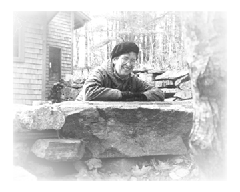
Author Linda Tatelbaum.
GELLERMAN: Linda Tatelbaum, a professor of English and environmental studies, has a new book out which combines her passion for language and the land. It’s called “Woman Who Speaks Tree: Confessions of a Tree Hugger."
TATELBAUM: One could do worse than be a hugger of trees, press the bark to your heart and feel the beat. Sap flows, pulse goes, trade oxygen and carbon dioxide. Merge
GELLERMAN: Linda Tatelbaum homesteads with her husband in a rural part of Maine.
Recently, the woman who speaks tree spoke with Steve Curwood about living life off the land.
TATELBAUM: I’ve probably been a tree hugger my whole life. But I think maybe I’m more – I’m a more devoted tree hugger now when my – in my sixties than I ever was.
CURWOOD: Linda, you love the place you live. Could you describe it for us?
TATELBAUM: Yes. It’s a clearing of about an acre in the middle of 92 acres of woods, and there’s a big garden where we raise all our vegetables and fruits and we have a house that’s solar electric. It’s a small house, built into a bank, so the back is, you know, sheltered from the cold and the warmth, so it’s very warm and cozy right now and cool in the summer.
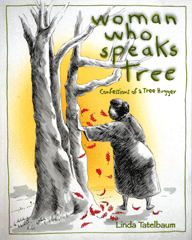
TATELBAUM: We felt rooted there and very committed to having the big garden and raising the vegetables and doing canning and putting stuff in the cellar and that whole rhythm was just very soothing to us.
CURWOOD: Many years ago, Linda Tatelbaum, you and I talked about your book “Carrying Water is a Way of Life.”
TATELBAUM: Yup.
CURWOOD: It was a – I think you called it a homesteader’s history.
TATELBAUM: Yes.
CURWOOD: And, you know, at the time you all didn’t have too much. You had to carry your water. You had to keep your stove going. You were short of power. You were off the grid and off the Internet and all that kind of stuff. Nowadays you have what – solar polar, things are pretty warm, you have a pump that pumps your water for you now.
TATELBAUM: Yup.
CURWOOD: And you got a phone and everything, I mean …
TATELBAUM: I have a computer. I’m on the Internet. I have everything.
CURWOOD: So, are you no longer a back-to-the-lander, just part of modern American society?
TATELBAUM: I don’t think so, because of the thing that we do most of our time in the summer – spring and summer – is work in the garden and produce a garden full of food, which I don’t think is the standard American way to spend the weekend. We also don’t spend very much money, we’re non-consumers, pretty much. And we look for the simplest way to do things. But our life is pretty comfortable, and I think that’s another lesson for people too who come and visit us is that they see that you can live that way and still be comfortable.

Linda Tatelbaum.
TATELBAUM: It’s definitely escapism, and I think our coming here, you know, thirty years ago was a form of escapism and getting focused on our life and our, you know, our own needs for wood and for food. And, you know, we keep up with the news, but we weren’t really being very active. So, I remember when I said to somebody, a student, actually, something about well I’m not an activist. And she said, “What are you talking about? Your whole life is activist.” And so I think that my writing is the way that I’ve been active, and I just hadn’t really credited it for that.
CURWOOD: There’s a moment in your book “Woman Speaks of Tree: Confessions of a Tree Hugger” where you write about your home life. I’m wondering if you could read to us from that section, page 83?
TATELBAUM: Sure, I’d be glad to. At the moment in history when we arrived at our place in Maine, we found the scattered remnants of the old settler’s kitchen. A rusted knife, the lid of a crock, blue mason jars, broken plates and cups reminded us that the first mission of life is to eat. Everywhere a tangle of plants grew without help from us two hippies and our books about organic gardening. If we’d never tilled the rocky soil to cultivate our chosen vegetables and fruits, we still could have feasted on wild blueberries, apples, dandelion greens, burdock roots, raspberries. Like the Sukeforth family of 1777, we whole crops into the kitchen and transform them into food, peel and chop, cook and eat. Potato, onions, corn. We insert a kitchen between us and the land, and tunnel our share of the abundance through mouth and gut on its way back to soil. Wielding a knife, we step into the cycle, partners in a porous dance with plants. Plant body becomes our body. Their oxygen becomes our breath. Our carbon dioxide is theirs. Eventually we will be eaten by what we ate. The body returns to soil. We move through the land, and it moves through us.
CURWOOD: The Sukeforths you write about those are the people who – the European farmers who were originally there some 200 years ago?
TATELBAUM: Yes. They were given the land as a payment for being mercenary soldiers in the Revolutionary War. It wasn’t a very good payment, though, because the land is pretty poor and it’s, you know, very rocky. They made the best of it. Then all their children died of small pox. And then they all eventually moved away. And the place was just abandoned when we found it.
CURWOOD: So your view of this is that you’re more of a steward than an owner of this place.
TATELBAUM: Yeah, and I feel like the trees and the plant life sort of watch us and, you know, we’ve come into their space and they’ve been there all the time. And I feel like whatever we do, we’re sort of being watched over by the trees, and I notice lately that some of the trees are getting pretty big and we have solar power, so it’s gonna be a struggle at some point to decide who gets to win.
CURWOOD: Uh-oh, you’re gonna cut down some of these trees.
TATELBAUM: We might have to. We’ve already cut down some pine trees that were blocking the sun – with apologies, of course.
[MUSIC: Billy Preston “Trees” from The Complete Vee Jay Recordings of Billy Preston (VeeJay Records/The Orchard 2002)]
GELLERMAN: Linda Tatelbaum’s new book is "Woman Who Speaks Tree: Confessions of a Tree Hugger." She spoke with Living on Earth’s Steve Curwood.
Related link:
For more on Linda Tatelbaum and her books, click here
Living on Earth is produced by the World Media Foundation. Our crew includes Ashley Ahearn, Bobby Bascomb, Eileen Bolinsky, Ingrid Lobet, Helen Palmer, Mitra Taj and Jeff Young, with help from Sarah Calkins and Marilyn Govoni. Our interns are Lindsay Breslau and Liz Gross. Special thanks this week to Jeff Silverman. Jeff Turton is our technical director. Alison Lirish Dean composed our themes. You can find us anytime at Loe.org. Steve Curwood is our executive producer.
I’m Bruce Gellerman. Thanks for listening.
ANNOUNCER: Funding for Living on Earth comes from the National Science Foundation, supporting coverage of emerging science, and Stonyfield Farm: organic yogurt and smoothies. Stonyfield pays its farmers not to use artificial growth hormones on their cows. Details at stonyfield.com.
Support also comes from you our listeners, the Ford Foundation, the Town Creek Foundation, and the Oak Foundation supporting coverage of climate change and marine issues; The Rockefeller Foundation and its Campaign for American Workers. More at rock found dot org. And Pax World Mutual Funds: socially and environmentally sustainable investing. Pax World: for tomorrow. On the web at paxworld.com.
ANNOUNCER: PRI, Public Radio International.
Living on Earth wants to hear from you!
Living on Earth
62 Calef Highway, Suite 212
Lee, NH 03861
Telephone: 617-287-4121
E-mail: comments@loe.org
Newsletter [Click here]
Donate to Living on Earth!
Living on Earth is an independent media program and relies entirely on contributions from listeners and institutions supporting public service. Please donate now to preserve an independent environmental voice.
NewsletterLiving on Earth offers a weekly delivery of the show's rundown to your mailbox. Sign up for our newsletter today!
 Sailors For The Sea: Be the change you want to sea.
Sailors For The Sea: Be the change you want to sea.
 The Grantham Foundation for the Protection of the Environment: Committed to protecting and improving the health of the global environment.
The Grantham Foundation for the Protection of the Environment: Committed to protecting and improving the health of the global environment.
 Contribute to Living on Earth and receive, as our gift to you, an archival print of one of Mark Seth Lender's extraordinary wildlife photographs. Follow the link to see Mark's current collection of photographs.
Contribute to Living on Earth and receive, as our gift to you, an archival print of one of Mark Seth Lender's extraordinary wildlife photographs. Follow the link to see Mark's current collection of photographs.
 Buy a signed copy of Mark Seth Lender's book Smeagull the Seagull & support Living on Earth
Buy a signed copy of Mark Seth Lender's book Smeagull the Seagull & support Living on Earth

